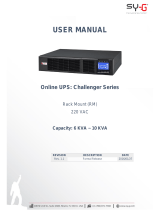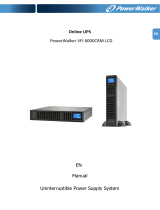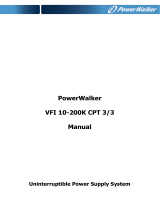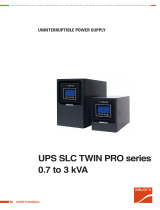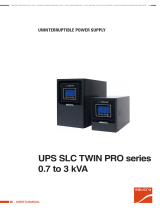Page is loading ...

DAKER DK Plus
1 kVA - 3 kVA
Manuel d’installation • Installation manual

33
Table of Contents
EN
1. Introduction 34
1.1 Use of the manual 35
1.2 Guarantee terms 35
1.3 Copyright 35
2. Safety Instructions 36
3. Installation 38
3.1 Package content 38
3.2 Tower configuration setup 39
3.2.1 UPS 39
3.2.2 UPS + battery cabinet (optional) 40
3.3 Rack configuration setup 41
3.4 Rear panel 43
3.5 Installation procedure 44
4. Operation 45
4.1 Control Panel 45
4.1.1 LCD Panel 45
4.1.2 Display description 46
4.2 Operating modes 47
4.3 Start-up procedure 48
4.3.1 Normal mode 48
4.3.2 Cold start 48
4.4 Shutdown 49
4.5 UPS Measurements 49
4.6 UPS settings 50
4.7 Settings shortcuts 55
4.8 Emergency Power Off (EPO) 55
4.9 Communication devices 56
5. Troubleshooting 57
6. Warehousing and dismantling 59
6.1 Warehousing 59
6.2 Dismantling 59
DAKER DK Plus
1 kVA - 3 kVA

34
1 Introduction
Congratulations on your recent LEGRAND purchase!
ATTENTION
It is necessary to read the whole manual carefully before doing any operation.
DAKER DK Plus must be used only in residential, commercial industrial environments.
The following diagram illustrates the architecture of the UPS system:
The major modules consist of:
• An AC-to-DC power converter (rectifier) with PFC control circuit.
• A DC-to-AC high frequency inverter.
• A battery charger.
• A battery bank.
• A DC-to-DC push/pull converter control circuit.
• A static bypass loop.
• Input and output EMI filters.

EN
35
1.1 Use of the manual
This manual must be kept in a safe, dry place and must always be available for consultation.
The manual reflects the state of the art when the equipment was put onto the market. This pub-
lication conforms to the standards current on that date; the manual cannot be considered inade-
quate when new standards come into force or modifications are made to the equipment.
INDICATION
The installation manual is an integral part of the equipment supplied and must therefore be kept
for its entire lifetime. In case of need (for example in the case of damage that even partially com-
promise its consultation) a new copy must be requested from the Manufacturer, quoting the pub-
lication code on the cover.
1.2 Guarantee terms
The terms of the guarantee may vary depending on the country where the UPS is sold. Check the
validity and duration with LEGRAND’s local sale representative.
The Manufacturer declines all indirect or direct responsibility arising from:
- failure to observe the installation instructions and use of the equipment which differs from the
specifications in the installation manual;
- use by personnel who have not read and thoroughly understood the content of the installation
manual;
- use that does not comply with the specific standards used in the country where the equipment
is installed;
- modifications made to the equipment, software, functioning logic unless they have been author-
ized by the Manufacturer in writing;
- repairs that have not been authorized by the LEGRAND Technical Support Service;
- damage caused intentionally, through negligence, by acts of God, natural phenomena, fire or
liquid infiltration.
1.3 Copyright
The information contained in this manual cannot be disclosed to third parties. Any partial or total
duplication of the manual which is not authorized in writing by the Manufacturer, by photocopy-
ing or other systems, including by electronic scanning, violates copyright conditions and may lead
to prosecution.
LEGRAND reserves the copyright of this publication and prohibits its reproduction wholly or in
part without previous written authorisation.
DAKER DK Plus
1 kVA - 3 kVA

36
2 Safety Instructions
This section contains important safety instructions that should always be followed during the in-
stallation, use and maintenance of the UPS.
• This product should be installed in compliance with installation rules, preferably by a qualified
electrician. Incorrect installation and use can lead to risk of electric shock or fire. Before carry-
ing out the installation, read the instructions and take account of the product’s specific mount-
ing location. Do not open up, dismantle, alter or modify the device except where specifically
required to do so by the instructions. All Legrand products must be opened and repaired ex-
clusively by personnel trained and approved by Legrand. Any unauthorised opening or repair
completely cancels all liabilities and the rights to replacement and guarantees. Use only Legrand
brand accessories.
• If any visible damage is found on the product during the unpacking operation, do not install the
UPS but repack the unit and return it to your reseller or distributor.
• Before operating the UPS or connecting any load equipment, ensure the UPS is connected to a
properly grounded electrical supply.
• The load applied must not exceed the one indicated on the type label of the UPS.
• The ON/OFF button of the UPS does not electrically isolate the internal parts. To isolate the UPS,
unplug it from the mains power socket.
• Do not attempt to open or disassemble the UPS; there are no user replaceable parts. Opening
the case will void the warranty and introduces the risk of electric shock even when the mains
plug is disconnected.
• The mains socket outlet that supplies the UPS shall be installed near the UPS and shall be easily
accessible.
• Do not plug non-computer-related items such as medical, life-support and house electric equip-
ments to the UPS output.
• Do not plug laser printers to the UPS output because they have a high start-up current.
• The UPS has its own internal energy source (batteries). If the UPS is switched on when no AC
power is available, there is hazardous voltage at the output sockets.
The batteries inside the UPS are not user-replaceable. Servicing of batteries must be
performed only by electrical hazard authorized personnel.
CAUTION: A battery can present a risk of electrical shock and high short circuit current.
The following precautions should be observed when working on batteries:
a) Remove watches, rings or other metal objects.
b) Use tools with insulated handles.
c) Wear rubber gloves and boots.
d) Do not lay tools or metal parts on top of batteries.
e) Disconnect the charging source prior to connecting or disconnecting battery terminals.
f) Determine if battery is inadvertently grounded. If inadvertently grounded, remove source
from ground. Contact with any part of a grounded battery can result in electrical shock.

EN
37
The likelihood of such shock can be reduced if such grounds are removed during installa-
tion and maintenance (applicable to equipment and remote battery supplies not having a
grounded supply circuit).
CAUTION: Do not dispose of batteries in a fire. The batteries may explode.
CAUTION: Do not open or mutilate batteries. Released electrolyte is harmful to the skin and
eyes. It may be toxic.
• This UPS has dangerous high voltages on its input and output connections. Contact with these
voltages may be life threatening.
• In case of emergency, immediately turn off the equipment and disconnect the power cord from
the AC power supply to disable the UPS.
• Do not allow any liquid or any foreign object to enter the UPS.
• The UPS is intended for indoor installation in a ventilated, controlled indoor environment with
a range of temperature between 0°C (+32°F) and +40°C (+104°F) and non-condensing humidity
between 20% and 80%.
• Do not install the UPS in locations with sparks, smoke and hazardous gas or where there is water
and excessive humidity. Dusty, corrosive, and salty environments can damage the UPS.
• Do not plug the UPS input into its own output.
• Do not attach a power strip or surge suppressor to the UPS.
• Do not cover the cooling vents and keep a clearance of 20 cm beyond the UPS rear panel. Avoid
exposing it to direct sunlight or installing it near heat emitting appliances.
• Unplug the UPS prior to cleaning and do not use liquid or spray detergent.
• Do not place the UPS near equipments that generate strong electromagnetic fields and/or near
equipments that are sensible to electromagnetic fields.
WARNING
All the UPSs are category C2 products according to the EN 62040-2. In a residential en-
vironment, these equipments may cause radio interference, in which case the user may be re-
quired to take additional measures.
DAKER DK Plus
1 kVA - 3 kVA

38
3 Installation
3.1 Package content
Check for the following package content:

EN
39
3.2 Tower configuration setup
3.2.1 UPS
DAKER DK Plus
1 kVA - 3 kVA

40
3.2.2 UPS + battery cabinet (optional)
3 Installation
S1

EN
41
3.3 Rack configuration setup
INDICATION
For the rack configuration setup it is also possible to use the rack support bracket kit 3 109 52. In
this case, follow the instruction sheet contained in the kit.
DAKER DK Plus
1 kVA - 3 kVA

42
3 Installation

43
EN
3.4 Rear panel
1. Emergency Power Off (EPO)
2. USB port
3. RS-232 port
4. Cooling fans
5. External battery connector
6. SNMP slot
7. AC input inlet
8. Input circuit breaker
9. Output circuit breakers
10. IEC type F outlets
11. IEC type J outlet
DAKER DK Plus
1 kVA - 3 kVA

44
3.5 Installation procedure
WARNING
Read the safety instructions on chapter 2 before installing the UPS.
1. Position the UPS so that the cooling fans are not obstructed, as visible in the following figure:
2. Connect the IEC input and output cables provided to the appropriate inlet and outlets.
3. Connect the loads to the IEC output cables, ensuring that the switches of the various loads are
in the off position.
4. Plug the UPS input cable into a main socket with a suitable voltage and current.
5. Connect the EPO contact in the UPS (normally closed)
3 Installation

45
EN
4.1 Control Panel
4.1.1 LCD Panel
ITEM DESCRIPTION
a
Display
b
The steady green LED indicates that the mains voltage is within the admittable
input voltage range
c d
The green LEDs indicate that the programmable outlets 1 and 2 are activated
e
The green LED blinks if the UPS is in bypass mode.
The steady green LED indicates that the UPS is in ECO mode.
f
The steady red LED indicates that there is an alarm
g
UPS power ON/Silence alarm
h
UPS power OFF
i
Special functions access menu
j
Go to the next screen
k
Go to the previous screen or change the setting of the UPS
l
Confirm a changed setting
4 Operation
DAKER DK Plus
1 kVA - 3 kVA

46
4.1.2 Display description
SIGN DESCRIPTION
Bypass Fault
Utility Input Fault
Site wiring Fault
Buzzer Silent
Overload
UPS Service mode
(reserved for LEGRAND Technical Support Service)
Alarm
UPS operation diagram
3-Digit Measurement Display
Measured item
Battery fault
Battery low
Battery test
4 Operation

47
EN
4.2 Operating modes
UPS OPERATING MODE LEDs/DISPLAY INDICATION BUZZER
NORMAL MODE
on-line, double conversion
LEDs: steady
, ,
DISPLAY:
No sound
STORED ENERGY MODE
The loads are supplied through
the batteries connected
to the UPS
LEDs: steady
, ,
DISPLAY:
Beep every
second
BYPASS MODE
The loads are supplied directly
from the mains. The UPS does
not protect the loads.
The UPS is in bypass mode after
a setting shortcut (paragraph
4.7), a generic alarm
or a prolonged overload
in normal mode.
LEDs: steady
, ,
DISPLAY:
Beep every two
seconds
ECO MODE
The loads are supplied directly
from the mains through
the automatic bypass circuit
inside the UPS. The output
voltage and frequency
are the same as the mains.
LEDs: steady
, , ,
DISPLAY:
No sound
CVCF 50/60
The UPS maintains constant the
output voltage and the output
fre quency to 50 Hz or 60 Hz
according to the setting.
With this operating mode it is
available only the 75% of the
nominal output power.
LEDs: steady
, ,
DISPLAY:
No sound
See also paragraph 4.6 to set the operating mode.
DAKER DK Plus
1 kVA - 3 kVA

48
4.3 Start-up procedure
4.3.1 Normal mode
1. Make sure the input breaker is not tripped. If it is, reset it.
2. Plug the UPS input cable into the mains socket.
3. The UPS turns to the standby mode in 5 seconds. The green LED
lights up if the input
voltage is within the admittable range and the fans spin. The battery charger is active. In this
condition the loads are not powered. The display looks like the following figure:
4. Press and hold it until the buzzer sounds twice.
The green LEDs
light up. The display looks like the following figure:
5. The start-up procedure is completed. Make sure that the batteries are fully charged or that the
UPS has been plugged to the wall receptacle at least for 4 hours before connecting the loads.
4.3.2 Cold start
1. Make sure the internal batteries or the external battery cabinets are connected to the UPS.
2. Press
and hold it until the buzzer sounds twice; then release the key. The display looks like
the following figure:
3. Press again and hold it until the buzzer sounds twice. If the second key confirmation is not
completed within 10 seconds, the UPS does not perform the cold start and shuts off.
4 Operation

49
EN
4. Few seconds after the second key confirmation, the UPS turns on in stored energy mode and the
loads are powered. The alarm LED
and the green LEDs light up. It is audible
an intermittent sound alarm.
The display looks like the following figure:
5. The start-up procedure is completed. If the UPS is not plugged to the mains outlet, the loads are
powered till the end of the backup time.
INDICATION
The output frequency is the same that there was at the input before the UPS was shutdown. The
default value is 50 Hz but if before the UPS shutdown the input frequency was 60 Hz, then the
output frequency after the cold start will be 60 Hz.
4.4 Shutdown
1. Press and hold until the buzzer sounds twice.
2. The UPS stops powering the loads and turns to the standby mode. The green LEDs
switch off. The ventilating fans continue spinning.
3. Unplug the UPS from the wall receptacle if there is still input voltage. After 10 seconds, the fans
stop working and the UPS completely shuts down.
4.5 UPS Measurements
After the UPS is turned on, it is possible to check the UPS measurements by pressing or
.
DAKER DK Plus
1 kVA - 3 kVA
The display sequence is:
- AC input voltage and current;
- AC input frequency;
- output voltage;
- output frequency;
- load percentage;
- output current;
- battery voltage;
- battery autonomy;
- UPS internal temperature;
- battery status, real and apparent power.

50
4.6 UPS settings
After the UPS is turned on, it is possible to check the UPS settings by pressing . The different
parameters can be scrolled pressing
.
It is possible to change only three parameters while the UPS is supplying the loads. One of these is
reserved to the LEGRAND Technical Support Service.
PARAMETER SETTING DISPLAY
BUZZER
ON
OFF
QUICK
BATTERY TEST
OFF
ON
BATTERY STATUS
TEST
This function
is reserved to
the LEGRAND
Technical Support
Service and must
not be activated
by the user
OFF
ON
4 Operation

51
EN
Follow this procedure to change the buzzer setting:
- press the
. The buzzer setting is displayed;
- press
to select ON or OFF;
- confirm the choice by pressing
.
The quick battery test can be performed to check the operation of the batteries. The test must be
performed only after the batteries are fully charged, the mains is available and the UPS is powering
the loads. Follow this procedure to perform the battery test:
- press
;
- press
to display the battery test setting;
- press
to select ON. The UPS transfers to stored energy mode for 10 seconds. During the test,
the loads are always powered with no voltage dip;
- if at the end of the test the UPS transfers back to normal mode without any alarm code, the bat-
teries are working properly.
To change all the other settings, the UPS must be in standby mode. In this condition the loads are
not powered, therefore all the needed settings must be performed before turning on the UPS.
Follow this procedure to change the UPS settings:
- press simultaneously
and for approximately three seconds, until the buzzer sounds
twice. The LCD displays the first setting indicated in the next table (“buzzer”);
- all the different settings can be scrolled pressing
;
- except for the buzzer and the battery test, all the other settings may be changed by pressing
;
- after changing settings, scroll to the “End” screen and then press
to save all changes;
- the UPS restarts automatically. However, it is also suggested to remove the mains for at least 30
seconds.
DAKER DK Plus
1 kVA - 3 kVA
/
